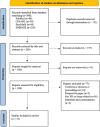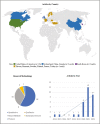Use of extended reality in sleep health, medicine, and research: a scoping review
- PMID: 37498981
- PMCID: PMC10636250
- DOI: 10.1093/sleep/zsad201
Use of extended reality in sleep health, medicine, and research: a scoping review
Abstract
Study objectives: This scoping review explores the use of extended reality (virtual, augmented, and mixed reality) within sleep health, sleep medicine, and sleep research. It aims to provide insight into current uses and implementation considerations whilst highlighting directions for future research.
Methods: A systematic scoping review was undertaken informed by the preferred reporting items for systematic reviews and meta-analyses for scoping reviews and Johanna Briggs Institute.
Results: The use of virtual reality (VR) as a research tool in the investigation of areas such as dreaming and memory reactivation is growing. Thirty-one articles were identified in total with 20 utilizing VR to improve sleep as a clinical intervention.
Conclusions: Research exploring the utility of VR as a clinical intervention in various patient populations and clinical settings is therefore warranted. Researchers and clinicians should ensure that extended reality interventions are developed based on clinical reasoning and informed by evidence of both sleep medicine and the effects of virtual and augmented reality. Where possible future research should utilize up-to-date technology and reporting frameworks to assist in the translation of research into clinical practice.
Keywords: augment reality; scoping review; sleep medicine; virtual reality.
© The Author(s) 2023. Published by Oxford University Press on behalf of Sleep Research Society.
Conflict of interest statement
No financial or nonfinancial benefits have been received or will be received from any party related directly or indirectly to the participant of this article.
Figures
Similar articles
-
The impact of extended reality on surgery: a scoping review.Int Orthop. 2023 Mar;47(3):611-621. doi: 10.1007/s00264-022-05663-z. Epub 2023 Jan 16. Int Orthop. 2023. PMID: 36645474 Free PMC article.
-
Facilitators and barriers to using virtual reality and augmented reality and its impact on social engagement in aged care settings: a scoping review protocol.BMJ Open. 2022 Aug 24;12(8):e061722. doi: 10.1136/bmjopen-2022-061722. BMJ Open. 2022. PMID: 36002222 Free PMC article.
-
Scoping review of the use of virtual reality in intensive care units.Nurs Crit Care. 2022 Nov;27(6):756-771. doi: 10.1111/nicc.12732. Epub 2021 Nov 15. Nurs Crit Care. 2022. PMID: 34783134
-
Implementation of virtual reality in healthcare: a scoping review on the implementation process of virtual reality in various healthcare settings.Implement Sci Commun. 2023 Jun 16;4(1):67. doi: 10.1186/s43058-023-00442-2. Implement Sci Commun. 2023. PMID: 37328858 Free PMC article.
-
What is the Current State of Extended Reality Use in Otolaryngology Training? A Scoping Review.Laryngoscope. 2023 Feb;133(2):227-234. doi: 10.1002/lary.30174. Epub 2022 May 12. Laryngoscope. 2023. PMID: 35548939
Cited by
-
Extended reality and information and communications technology in therapy: Enhancing remote artistic and recreational engagement for physically impaired and socially isolated patients.Digit Health. 2025 Jun 25;11:20552076251350440. doi: 10.1177/20552076251350440. eCollection 2025 Jan-Dec. Digit Health. 2025. PMID: 40585059 Free PMC article.
-
Extended Reality Head-Mounted Displays Are Likely to Pose a Significant Risk in Medical Settings While Current Classification Remains as Non-Critical.Microorganisms. 2024 Apr 17;12(4):815. doi: 10.3390/microorganisms12040815. Microorganisms. 2024. PMID: 38674759 Free PMC article. Review.
-
Assessing the knowledge, attitude and perception of Extended Reality (XR) technology in Pakistan's Healthcare community in an era of Artificial Intelligence.Front Med (Lausanne). 2024 Oct 16;11:1456017. doi: 10.3389/fmed.2024.1456017. eCollection 2024. Front Med (Lausanne). 2024. PMID: 39478829 Free PMC article.




